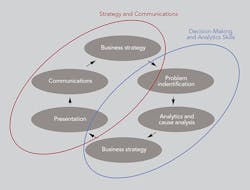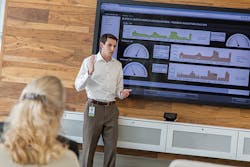As smart technologies grow in their importance to modernized grid operations, more and more utility personnel are being asked to leverage the reams of new data available from these advanced devices to improve the effectiveness of their decision-making processes. Data analytics is the new methodology to extract increasing value from smart devices. However, data analytics is not just about data and analytics, it also is about strategy and communications. It is becoming an ever-increasing expectation for everyone in the utility to become data scientists — to effectively identify pertinent data, leverage it appropriately, make informed and supported business decisions, and convey these data-driven recommendations in a coherent and logical way.
A simple examination of most utility organizations today will find a plethora of analysts throughout the enterprise. However, how many of these roles are truly leveraging data analytics and providing data-driven improvements to the business? Too often, today’s analysts are, in fact, report generators or routine process executors. Too many roles in today’s utility are titled as analyst while very few actually exercise real, data-based, analytics-enabled, problem solving to improve utility operations.
The biggest obstacle most utilities face in leveraging the availability of new data is having the people and skills to use it. Having the data alone is not enough. Utilities need analysts who can identify the right issue to solve based on key business objectives; identify the right data to use that is truly relevant to the issue; understand what the data is showing, and eliminate personal and analytical bias; and effectively convey the results and recommendations to management.
The First Step
A positive trend is becoming evident that indicates the recognition of this need in many utilities. That is, large enterprises are beginning to devote key roles to data analytics. Utilities are developing specific positions to elevate the need to extract value from new data sources. New titles such as chief data or analytics officer (not to be confused with chief information officer or chief technology officer), or director of data analytics or grid analytics, are now becoming a reality.
However, having a chief scientist is only the first step. This new trend of hiring (or simply designating) analytics managers and data scientists to drive data analytics into the utility is not enough. The smart person in the corner of the room, so to speak, will not transform the utility into a smart utility without the cultural and organizational change that will be required across the broad spectrum of utility analyst roles. Rather, utilities need to turn traditional analysts into more complete smart utility analysts.
To do this, a more comprehensive knowledge worker must be developed, including not only the data and analytics skills, but also the problem-solving skills and strategic understanding of the business domain coupled with effective communications skills. This worker must adopt the complete ecosystem of data-driven decision making, as represented by an analytics life cycle.
This strategically aligned, data-enabled, decision-making life cycle integrates two critical elements of effective smart utility analytics: strategy and communications skills with decision-making and problem-solving skills. These two key skills combine into a sequential life cycle not only to ensure the right problems are examined but that those problems are analyzed effectively, the strategy is supported and defensible, and the results are portrayed effectively to be adopted and put into practice. Developing and enabling these diverse skills within utility analysts represents a powerful strategic enabler but also a challenging change-management initiative.
Strategy and Business Alignment
The first element of the ecosystem is critical to all the rest. Unless the process begins with a well-understood problem statement, no amount of powerful analytics will provide a sound result. There cannot be a good answer if there is not a good question on which to focus the effort. Furthermore, regardless of the quality and quantity of the analysis, if the problem being analyzed is not important to the business (as defined by its strategy), then the effort is wasted. Hence, aligning and prioritizing the business issues to be examined with key business strategies is a critical first step. If executed effectively, a clear problem statement will help a utility in two ways:
- Gain sponsorship and management support by aligning the analysis directly with key business objectives and goals
- Identify the right problem to be solved, eliminate side trails and make the analysis focused, directed and efficient.
Decision-Making and Analytics Skills
Once the problem is clearly identified and tightly defined, the traditional analytics work can move forward in an efficient and targeted way. It is important to adopt a structured, repeatable approach that can be applied effectively to all analytics problems. This will ensure consistency and reliability, and instill recurring confidence within management that the results are not biased and the analysis stronger or weaker depending on who executed it. There are many problem-solving methodologies to be considered, including Six Sigma methods, the Kepner-Tregoe problem-solving and decision-making process, and others. It is important to choose a methodology that creates confidence and completeness, and then ingrain it into recurring utility decision-making processes.
Given a reliable and repeatable methodology, if a utility has the right data, the analysis is a lot easier. Hence, another important element is to find the right data and understand how to read it. This includes identifying what data a utility needs, what data it has, the reliability of the data, where a utility can get it and how easy it is to use it. Finally, as a utility crunches the data through manipulations, scenario analysis, aggregation and disaggregation, correlations and regressions, and more, it is important to ensure the quality of the data is not being degraded through these machinations. Thus, version control and edit management become essential disciplines to maintain.
Finally, powerful data analytics can be wasted if the analyst cannot see the forest through the trees. The power of data is only as good as analysts’ ability to understand what it is telling them. This is where contextual understanding, visualization and results representation become critically important to arriving at the right answer and the right recommendations. This also is where a utility may be most susceptible to the greatest trap. That is, data can be manipulated to provide any answer the analyst wants through selective data filtering and biased analysis.
Communications and Results Portrayal
The life cycle is completed with the effective communication of the results and recommendations. Effective visualizations used in analyzing results are often useful in portraying the prudency of the recommendations. However, presentation overload is a deadly mistake and one that is made too often. The key is to effectively present data-supported recommendations in a logical and simple way. The analyst must be able to convert the technical and data analytics into logical recommendations and consumable messages.
One of the most effective methods is to tell a story that follows the path to the logical answer. Use a rational progression so the audience can follow the problem, the analysis and the results to the commonsense conclusion, starting with the clearly articulated problem statement and its support of the utility’s objectives. Translate the technical and data analytics into reasonable recommendations and consumable messages. Do not drown the audience with unnecessary detail just because it exists.
An effective presentation of complex concepts and analytics can help to overcome obstacles and definitively answer questions with simple, clear evidence. As with any effective communication, it is critical to understand who the audience is, what their interests and motivations are, and how they best consume information. Tailor each review of the analysis and results to the key decision makers or stakeholders present.
The Complete Decision Analyst
Enabling this complete ecosystem within a single analyst is a difficult and challenging endeavor. These skills are rare within one individual and will have to be developed, refined and improved continuously. However, the benefit is immeasurable and the capability is foundational to running an effective, data-driven smart utility.
Complete smart utility analysts — those who can effectively navigate the complete life cycle — are invaluable assets who can deliver these benefits:
- More effective problem solving
- Group-think problem solving, leading to more creative solutions
- More engaged personnel and improved morale
- Greater adoption and ownership, through involvement
- More efficient and easier transitions.
In summary, effective use of the new capabilities of data analytics must include more than just data and analytics. It also must include effective strategy and communications. Data scientists and data analysts will need to be more than mathematicians and report generators, they will need to become problem solvers. Transitioning to a data-driven decision-making organization will require the integration of the complete analytics life cycle into all aspects of the organization. Data scientists cannot execute this alone.
This is not a simple, quick transformation. It requires effective management, organizational evolution and continuous personnel improvements. The result can be very powerful, but the journey is evolutionary for most utilities. Let the journey begin.
Ron Katzman ([email protected]) leads the smart grid operations at PECO, an Exelon Co. His team focuses on managing and optimizing the performance of the smart grid systems and acts as a service delivery organization, delivering complete, accurate and timely advanced metering infrastructure and distribution automation data to the various PECO stakeholder groups. Katzman is a Six Sigma Black Belt, and holds an engineering degree from Lehigh University and an MBA degree from the University of Utah.
Jeff Buxton ([email protected]) is an executive consultant for Black & Veatch focused on distribution utilities operational technologies. He has more than 30 years of experience within the energy, utilities, information technology and technology sectors. His experience encompasses strategic business planning, technology road map development, program management, executive and marketing communications, change management and operations planning. Buxton received an MBA degree in marketing with distinguished honors from the University of Cincinnati and a BSEE degree from Pennsylvania State University.
The Journey at PECO
PECO has been living the transformation to a complete analytics life cycle since it began its advanced grid and metering program, Smart Future Greater Philadelphia. With the support of a U.S. Department of Energy smart grid investment grant, PECO has implemented several advanced grid technologies that deliver enhanced distribution operations data.
As part of this infusion of new technology, PECO has implemented a new group to oversee the successful implementation of these new capabilities. The responsibility of the group is to act as a service delivery organization within PECO, with the mission to deliver complete, accurate and timely data to stakeholder groups to improve their efficiency and operational effectiveness.
This group requires the ability to apply data analytics effectively to its own operational processes to manage the advanced grid network. PECO has begun the process of transforming data analysts into more complete data scientists by applying many of these principles within its advanced grid operations team. The following disciplines have been adopted already:
- Begin every problem-solving exercise with a problem statement and ensure the problem is worth trying to solve.
- Assure that clear operational definitions exist for all data and metrics to ensure data sources and reliability for problem solving are clearly understood.
- Use the analytics tools to apply correlations and visualizations to data from multiple disparate sources to understand what the data is implying.
- Create effective storylines in the portrayal of results and recommendations so stakeholders and management fully understand the basis of the results.
The journey to transforming data analysts into data scientists will be a continuous effort. However, PECO is proving the results can be powerful and the journey is worthwhile.




